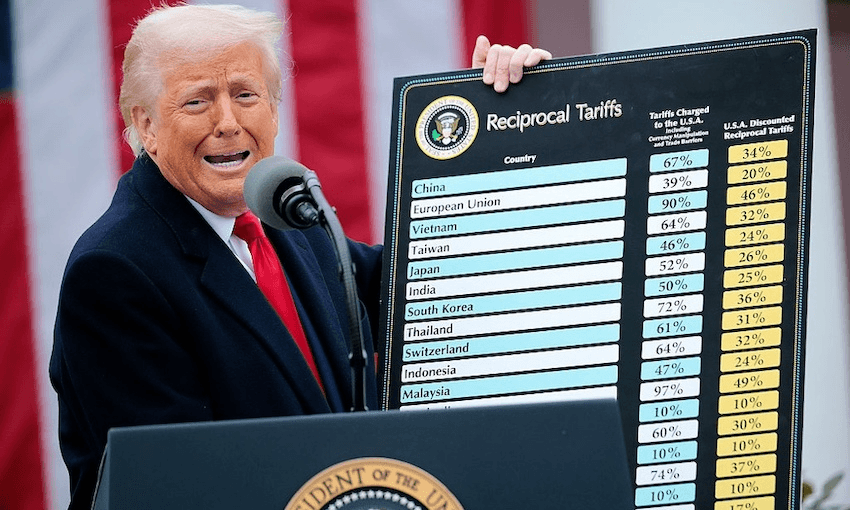The US president’s sweeping programme of global tariffs will hit every country abroad, including New Zealand, and dramatically raise prices at home.
This is an excerpt from The World Bulletin, our weekly global current affairs newsletter exclusively for Spinoff Members. Sign up here.
In a dramatic, flag-draped address from the White House Rose Garden, Donald Trump today announced what he called a “declaration of economic independence” – a sweeping global tariff programme that will impose new import duties on nearly every trading partner of the United States. “April 2, 2025, will forever be remembered as the day American industry was reborn, the day America’s destiny was reclaimed and the day that we began to make America wealthy again,” the president declared.
The centrepiece of the policy is a baseline 10% tariff on all goods from every country except Canada and Mexico, which have already been hit with tariffs of up to 25%. On top of the standard 10%, which is what New Zealand will pay, 60 nations labelled “worst offenders” will be hit with reciprocal tariffs mirroring the duties they place on US goods. Some of the sharpest increases target China (34%, on top of its existing 20% tariff), Vietnam (46%), Cambodia (49%) and the EU (20%). A separate, across-the-board 25% tariff on foreign-made cars will also kick in at midnight. “For years, hard-working American citizens were forced to sit on the sidelines as other nations got rich and powerful, much of it at our expense,” Trump said. “But now it’s our turn to prosper.”
‘Worse than the worst-case scenario’
Wall Street did not share Trump’s sense of triumph. Markets, which had closed higher earlier in the day, plummeted in after-hours trading as the sheer scale of the new tariffs became clear. Dow futures fell by over 250 points, the S&P 500 dropped nearly 1.7%, and the Nasdaq 100 slid a punishing 2.5%. “This is worse than the worst-case scenario of the tariffs that many in the market expected,” said CNBC’s Jon Fortt, stunned by the breadth of the measures.
Economists were equally alarmed. Justin Wolfers, writing on Bluesky, described the tariffs as monstrously destructive, founded on “fabrications, imagined wrongs, discredited theories and ignorance of decades of evidence”, warning they will ultimately hurt working Americans most. Michael Pearce of Oxford Economics echoed the sentiment, saying the surprise severity of the announcement would force him to revise his US inflation forecast even higher than it is now. While Trump insists the tariffs will revive US manufacturing and reduce the national debt, critics argue they may instead trigger global retaliation, drive up consumer prices and push the US closer to recession.
What it means for New Zealand
Speaking to reporters, trade minister Todd McClay said that while the 10% blanket tariff on exports to the US was a bitter pill to swallow, New Zealand had got off comparatively lightly. According to Thomas Manch in The Post (paywalled), NZ exported about $9bn worth of goods to the US last year; with a 10% tariff that would signal about $900m in costs, which McClay said would likely be worn “by US consumers, not New Zealand exports”. He said the government will be “working very closely with our exporters during the course of today … to get as much information as we can”.
The minister said he would ask trade officials in Washington to raise an apparently erroneous claim by the US that New Zealand imposes a 20% tariff on US imports – in fact the average tariff is 1.9%. Westpac chief economist Kelly Eckhold told RNZ that the US had likely come to that figure through “a combination of the GST rate plus we do have some tariffs against the US in some products set at a minimum WTO agreed level”. But given that explanation, he said it made no sense that the stated tariff for Australia was 10%. “They also have a GST, and similarly the United Kingdom is assessed at 10 as well and they have a value-added tax.”
A new world trade order emerges
For global markets, it’s all bad news – but in the long term, perhaps not quite as bad as it seems. Amid the chaos of Trump’s trade war, countries are quietly building a new trade architecture that bypasses the United States altogether, writes the Economist (paywalled). The Comprehensive and Progressive Agreement for Trans-Pacific Partnership, or CPTPP, was once an American-led initiative, but the 12-member pact – which includes New Zealand – now thrives without it. Meanwhile Europe has raced to sign deals with Mercosur, Mexico and others, propelled in part by Trump’s earlier tariff shocks.
These efforts reflect a declining reliance on the US, whose share of global imports has shrunk from a fifth at the turn of the century to just an eighth today. As services now dominate the US economy, demand for imported goods has plateaued – and that represents an economic opportunity for other countries. “The EU and its open-market allies could form a formidable bloc – coordinating responses to American tariffs and pulling China in a more free-trading direction,” writes the Economist. “Even without China, however, the open-market bloc is big enough to rebuild a trade order from the wreckage of Mr Trump’s war. This may be a dark time for free-traders, but there are glimmers of hope.”
